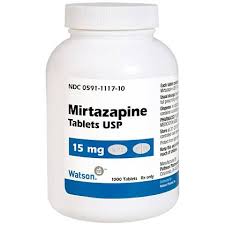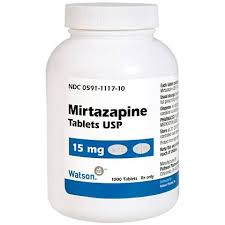Providing Quality & Trust || Clinic Website
Detailed Description
Mirtazapine
(mir-taz-ah-peen)
- Category: Tetracyclic Antidepressant; Antiemetic; Appetite Stimulant
- Other Names for this Medication: Remeron®
- Common Dosage Forms: Veterinary: None. Dosages may need to be made (compounded) to accurately dose cats and small dogs.
In dogs and cats, mirtazapine may be useful as an appetite stimulant and to prevent vomiting and motion sickness. The FDA has approved this drug for use in humans, but it is not officially approved for use in animals. The FDA allows veterinarians to prescribe products containing this drug in different species or for other conditions in certain situations. You and your veterinarian can discuss why this drug is the most appropriate choice.
- May be given with or withoutfood. If your animal vomits after receiving mirtazapine on an empty stomach, give with food or treatto see if this helps. If vomiting continues, contact your veterinarian.
- Tolerated well in dogs. More side effects seen in cats, and dose may need to be adjusted if they occur. Common side effects: vocalization, behavior changes, and tremors or shaking. Report excessive drowsiness or vocalization to your veterinarian.
- If your animal is receiving the orally disintegrating tablets, make sure hands are dry before handling the tablet. Place the tablet under the animal’s tongue and hold mouth closed for several seconds to allow itto dissolve (should occur quickly). After the tablet has melted, offer your animal water.
Prescriber Highlights:
- Transdermal form is labeled for management of weight loss in cats. Also used in tablet form as an appetite stimulant and antiemetic in dogs and cats with chronic kidney disease (CKD)
- Can be used in conjunction with other antiemetics
- Primary adverse effect is sedation. In cats, vocalization and increased affection can be noted.
- The lowest effective dose should be used to reduce sedative properties. Doses should not exceed 30 mg/day in dogs when using for appetite stimulation.
- Owners handling transdermal mirtazapine should wear gloves. Humans and other animals in the household should avoid contact with the treated cat for at least 2 hours after transdermal administration.
Uses/Indications:
Transdermal mirtazapine is indicated in the management of weight loss in cats. In a study, average weight gain was 3.9% of body weight after a 2-week course of therapy. In another study, cats ingested significantly more food when receiving mirtazapine tablets as compared with placebo. No difference in food ingestion was noted between the 2 groups, but high doses (ie, 3.75 mg) of mirtazapine were associated with significantly more noticeable behavior changes.
The drug is an effective appetite stimulant and has antiemetic activity in cats with CKD. In a study of healthy dogs, mirtazapine accelerated gastric emptying and colonic transit without having an effect on small intestine transit. Other potential veterinary uses of mirtazapine could include treatment of chemotherapy-induced nausea and vomiting, behavior-related conditions, congestive heart failure, GI disorders, liver disease, and neoplasia.
Adverse Effects:
Mirtazapine appears to be well tolerated in both dogs and cats at the appropriately prescribed dosages. In a study evaluating the adverse effects of mirtazapine in cats, the 10 most common adverse effects seen (listed from most frequent to least frequent) were vocalization (56%), agitation (31%), vomiting (26.2%), abnormal gait/ataxia (16.7%), restlessness (14.3%), tremors/trembling (14.3%), hypersalivation (13%), tachypnea (11.9%), tachycardia (10.7%), and lethargy (10.7%). Only one cat that received the 1.88 mg dose had adverse effects, whereas 25 cats that received a dose of 3.75 mg displayed adverse effects. Other adverse effects reported during the study included anorexia, disorientation, dyspnea, hypothermia, mouth breathing/panting, mydriasis, behavior changes, depression/sedation, fasciculations, hyperactivity, hypertension, pacing, dysphoria, inappropriate elimination, polyphagia, circling, discomfort, hiding, inappetence, seizures, and weakness.10 Increases in liver enzymes have been reported in some cats receiving mirtazapine. In a study, cats experienced more adverse effects with 3.75 mg doses as compared with 1.88 mg doses.10
Transdermal mirtazapine may cause application site reactions (eg, erythema, crusting/scabbing, residue) in ≈ 10% of cats.
What are the side effects of this medication?
Mirtazapine is usually well tolerated in dogs and side effects are rarely seen. In cats, mirtazapine may cause more side effects that, if they occur, can often be seen within 90 minutes of a dose. Reducing the dosage or giving smaller doses more often may help limit these adverse effects.
Side effects that usually are not serious include:
- Vocalization. Mild tremors or shaking.
- Sleepiness or sedation (fatigue).
- Increased affection (cats).
You don’t have to be overly concerned if you see any of these unless they are severe, worsen, or continue to be a problem. Contact your veterinarian if this happens.
Precautions/Warnings:
Mirtazapine is contraindicated in patients hypersensitive to it and in those that have received monoamine oxidase inhibitors (eg, selegiline) in the past 14 days. Transdermal mirtazapine should not be administered orally or in the eye.
Mirtazapine has been associated with orthostatic hypotension in humans and should therefore be used with caution in patients with known cardiac disease or cerebrovascular disease that could be exacerbated by hypotension. Patients with renal impairment, renal failure, or hepatic disease may require lower doses of mirtazapine and should be closely monitored while receiving mirtazapine. Mirtazapine has rarely been associated with hyponatremia in humans; caution should be used in patients receiving a diuretic or other medication that could decrease sodium levels.
Abrupt discontinuation of mirtazapine after long-term administration has resulted in withdrawal symptoms such as nausea, headache, and malaise in humans. In general, antidepressants may affect blood glucose concentrations due to their indirect effects on the endocrine system; caution should be used in patients with diabetes mellitus.
Mirtazapine exhibits very weak anticholinergic activity; consequently, vigilance should be used in patients that might be more susceptible to these effects (eg, those with urinary retention; prostatic hypertrophy; acute, untreated closed-angle glaucoma or increased intraocular pressure; GI obstruction or ileus). Effects of mirtazapine may also be additive to anticholinergic medications.
Extra care should be taken in active animals, as mirtazapine may impair concentration and alertness. Although extremely rare, mirtazapine has been associated with blood dyscrasias in humans and should be used cautiously in patients with pre-existing hematologic disease, especially leukopenia, neutropenia, and/or thrombocytopenia. Prolongation of the QT interval has been reported, and risk may increase with other QT-prolonging drugs.
If you have any other questions or concerns about this medication, contact your veterinarian or pharmacist.
Powered by nopCommerce
This site is running in live payment mode. Real payments will be processed.

